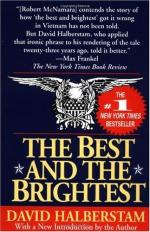
|
| Name: _________________________ | Period: ___________________ |
This test consists of 15 multiple choice questions and 5 short answer questions.
Multiple Choice Questions
1. What does Halberstam say the administration had led the American people to believe about the war?
(a) That American air power would win the war quickly.
(b) That it would not be a large war.
(c) That the war would pay for itself.
(d) That international consensus would build in support of America's actions.
2. Why did President Johnson authorize bombing attacks on North Vietnam, in Halberstam's account?
(a) He believed that if Vietnam went Communist, the rest of the region would turn Communist as well.
(b) He thought that breaking Vietcong resistance would create trade opportunities for American companies.
(c) He thought that bombing was a final resort, and after it failed, he could strategically withdraw.
(d) He thought that an overwhelming display of force would convince other nations in the region to accept American influence.
3. What kind of problem does Halberstam say the cost of the war caused for the Johnson administration?
(a) Moral problems.
(b) Public relations problems.
(c) Disclosure problems.
(d) Budget problems.
4. What does Halberstam say became clear by the time Rolling Thunder had been in effect for six weeks?
(a) That it was only a matter of time until Hanoi capitulated.
(b) That Rolling Thunder was breaking the Vietcong supply routes.
(c) That Rolling Thunder was not breaking the North's resistance.
(d) That Rolling Thunder was not going to make Hanoi capitulate.
5. What plan was the U.S. government following by the end of 1964?
(a) Limit bombing but increase troops on the ground.
(b) Expand the pacification program.
(c) Restrict operations to bombing missions.
(d) Pour as many resources as necessary into Vietnam.
6. How did Lyndon Johnson want to be remembered, in Halberstam's account?
(a) As an expert.
(b) As a force for peace.
(c) As a diplomat.
(d) As an achiever.
7. Who does Halberstam say was making the case for bombing after the 1964 election?
(a) Bundy.
(b) Harkin.
(c) Harriman.
(d) McNamara.
8. How did McNamara's position on bombing change over time?
(a) Years later, he would say that he had doubts about how useful bombing would be.
(b) After a few months, he was convinced of bombing's effectiveness.
(c) After a year, he reversed his position entirely.
(d) After the first weeks, he was sure that bombing would end the war.
9. What does Halberstam say was the conclusion of the study that analyzed the results of a bombing attack against the north?
(a) The report concluded that bombing would overwhelm the people, and drain support for further attacks.
(b) The report concluded that bombing would break the Vietcong's supply routes, and end resistance.
(c) The report concluded that bombing would strengthen the North by building opposition to the Americans.
(d) The report concluded that bombing would deter any further guerilla-style attacks against the South.
10. Who traveled to Vietnam after the 1965 inauguration?
(a) Taylor, Ball and Bundy.
(b) McNamara, Ball and Harriman.
(c) Bundy, McNamara and Rusk.
(d) Westmoreland, Harriman and Rusk.
11. Who does Halberstam say eventually took on the role of setting the tone for Vietnam policy?
(a) Rusk.
(b) Harriman.
(c) Taylor.
(d) Bundy.
12. When does Halberstam say that McNamara realized he had been misled about the conditions in Vietnam?
(a) When he read the military reports in December 1963.
(b) When he received envoys from Vietnam in March of 1964.
(c) In his December 1963 trip to Vietnam.
(d) In his March 1964 trip to Vietnam.
13. What does Halberstam say was going to cause the realities of the war to be made public?
(a) The process of paying for the war.
(b) The media.
(c) Passage of the Freedom of Information Act.
(d) Leaks from inside the government.
14. What does Halberstam say Maxwell Taylor discovered was true about Khanh?
(a) Khanh was an opportunist and a bad strategist.
(b) Khanh was another Diem.
(c) Khanh was an ineffectual leader.
(d) Khanh was self-serving and corrupt.
15. Why does Halberstam say that September and October of 1963 were good for the Kennedy administration?
(a) The administration was prepared to pick up seats in special elections.
(b) There was accord on civil rights issues.
(c) Averell Harriman made progress on the test ban treaty.
(d) The military made progress in the Mekong Delta.
Short Answer Questions
1. When does Halberstam say the Johnson administration realized that Bundy was necessary to their planning?
2. What did Hanoi do in response to U.S. war games in the South?
3. What movement regarding the war does Halberstam say started at the University of California in Berkeley?
4. What event does Halberstam say triggered bombing operations against the North?
5. What problem does Halberstam say McNamara discovered in Vietnam?
|
This section contains 837 words (approx. 3 pages at 300 words per page) |

|




